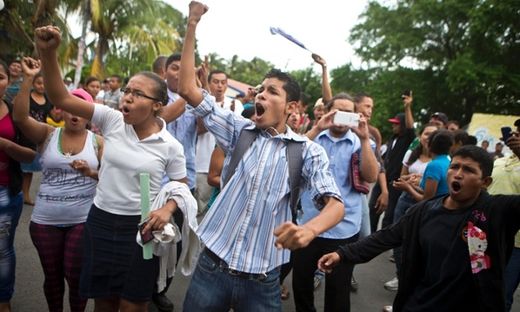Dozens injured as Nicaraguans protest canal construction, removal from their lands

© Esteban Felix / AP
A protest march in San Jorge against the construction of the planned interoceanic canal.
Scores of Nicaraguan protesters have been arrested and dozens injured as Nicaraguan police broke up road blocks set up by demonstrators protesting this week against possible eviction from their lands due to the construction of an interoceanic canal in the country.
Protesters in Rivas blocked the Pan-American Highway shortly after the official ceremony marking the beginning of construction work. Another road block on the Managua-San Carlos Highway was set up by protesters from the community of El Tule and the municipality of Nueva Guinea, which are also on the proposed canal route.
Although in a recent press conference, Chinese businessman Wang Jing, the president of HKND Group, the company building the canal, promised to pay "compensation according to market principles in a fair, open and transparent way", many peasants complained of a lack of information when workers turned up to measure their land accompanied by police officers and soldiers. This has generated uncertainty among the campesino farmers affected and some have even said they won't give up without a fight.
At a meeting of protesters in November, one farmer told the Guardian, "We'll use machetes, stones, anything to protect our land. My grandparents were born here. They say they are going to pay me, but I never put the land up for sale."
Police moved in on Tuesday evening in Rivas, where protesters had threatened to burn a petrol tanker if any attempt was made to remove them, but did not do so. According to the Nicaraguan daily newspaper La Prensa, about 40 people were arrested by riot police, including Octavio Ortega Arana, who has been heading up the protests in that department and is reportedly being held in Managua.
Police Chief Aminta Granera said there had been 33 arrests in the Managua-San Carlos Highway roadblock, government publication el19digital reported.
The road block in El Tule was broken up amid violent scenes in the early morning of Christmas Eve, with La Prensa initially reporting over 50 campesinos injured in clashes with the police. The previous day, the president of the opposition Sandinista Renovation Movement, Ana Margarita Vijil, was held for over six hours by the National Police after attempting to reach the protest.
Granera stated that the protesters were violating people's rights to move around the country freely, affecting commerce and tourism. She stated that the police acted with "tolerance and peace".
"Faced with the use of firearms, machetes, stones and sticks by the protesters, the special troops responded with tear gas and rubber bullets," Granera said. Fifteen police officers were injured, with three seriously injured, she said. One of three was shot in the lung and is in critical condition.
As preliminary work has begun on an access road and a wharf to bring in the heavy machinery needed to build the canal, there is a real possibility that the HKND project will finally realise a Nicaraguan dream that reaches back to the early days of the Spanish conquest.
The government is selling the canal as an economic miracle that will permanently resolve the country's poverty, bringing an abundance of much-needed jobs to Nicaragua. Critics have highlighted the lack of information in a project fast-tracked through the Nicaraguan parliament with little debate - things like major environmental consequences, particularly to Lake Nicaragua, and the fact that it will cut through lands belonging to Creole communities and the Rama indigenous community.


0 reacties:
Post a Comment